Unit 1基础语法部分
- 格式:docx
- 大小:24.90 KB
- 文档页数:7
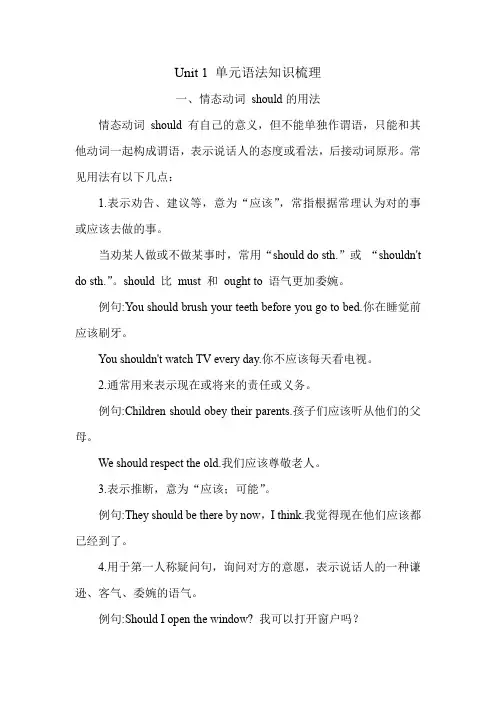
Unit 1 单元语法知识梳理一、情态动词should的用法情态动词should有自己的意义,但不能单独作谓语,只能和其他动词一起构成谓语,表示说话人的态度或看法,后接动词原形。
常见用法有以下几点:1.表示劝告、建议等,意为“应该”,常指根据常理认为对的事或应该去做的事。
当劝某人做或不做某事时,常用“should do sth.”或“shouldn't do sth.”。
should 比must 和ought to 语气更加委婉。
例句:You should brush your teeth before you go to bed.你在睡觉前应该刷牙。
You shouldn't watch TV every day.你不应该每天看电视。
2.通常用来表示现在或将来的责任或义务。
例句:Children should obey their parents.孩子们应该听从他们的父母。
We should respect the old.我们应该尊敬老人。
3.表示推断,意为“应该;可能”。
例句:They should be there by now,I think.我觉得现在他们应该都已经到了。
4.用于第一人称疑问句,询问对方的意愿,表示说话人的一种谦逊、客气、委婉的语气。
例句:Should I open the window? 我可以打开窗户吗?What should we do now? 我们现在该干什么呢?5.表示某种感情色彩,意为“竟会”,常用于以how, why开头引导的特殊疑问句中。
例句:Why should you be so early today? 你今天为什么会如此早?二、反身代词1.反身代词的构成反身代词是一种表示反射或强调的代词。
它由第一人称、第二人称的形容词性物主代词和第三人称代词的宾格加词尾-self或-selves构成。
其构成如下表:反身代词与它所指代的名词或代词形成互指关系,两者在人称和数上应保持一致。
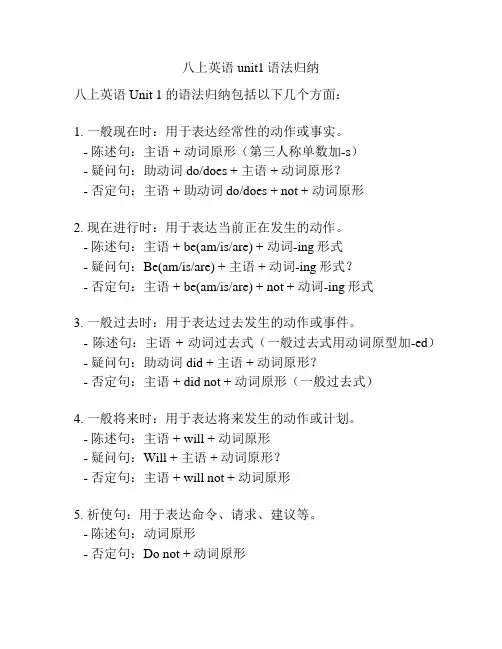
八上英语unit1语法归纳
八上英语Unit 1的语法归纳包括以下几个方面:
1. 一般现在时:用于表达经常性的动作或事实。
- 陈述句:主语 + 动词原形(第三人称单数加-s)
- 疑问句:助动词do/does + 主语 + 动词原形?
- 否定句:主语 + 助动词do/does + not + 动词原形
2. 现在进行时:用于表达当前正在发生的动作。
- 陈述句:主语 + be(am/is/are) + 动词-ing形式
- 疑问句:Be(am/is/are) + 主语 + 动词-ing形式?
- 否定句:主语 + be(am/is/are) + not + 动词-ing形式
3. 一般过去时:用于表达过去发生的动作或事件。
- 陈述句:主语 + 动词过去式(一般过去式用动词原型加-ed) - 疑问句:助动词did + 主语 + 动词原形?
- 否定句:主语 + did not + 动词原形(一般过去式)
4. 一般将来时:用于表达将来发生的动作或计划。
- 陈述句:主语 + will + 动词原形
- 疑问句:Will + 主语 + 动词原形?
- 否定句:主语 + will not + 动词原形
5. 祈使句:用于表达命令、请求、建议等。
- 陈述句:动词原形
- 否定句:Do not + 动词原形
6. There be句型:表示存在或出现的情况。
- 陈述句:There is/are + 名词 + 其他
- 疑问句:Is/Are there + 名词 + 其他?
- 否定句:There is/are not + 名词 + 其他
以上是八上英语Unit 1的语法归纳,希望对你有帮助。
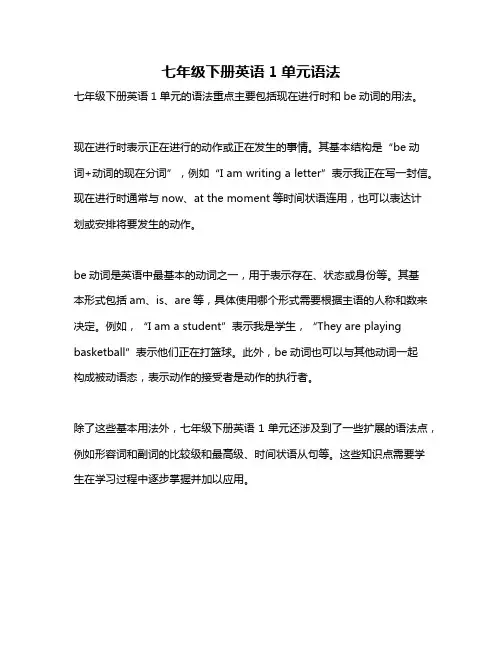
七年级下册英语1单元语法
七年级下册英语1单元的语法重点主要包括现在进行时和be动词的用法。
现在进行时表示正在进行的动作或正在发生的事情。
其基本结构是“be动
词+动词的现在分词”,例如“I am writing a letter”表示我正在写一封信。
现在进行时通常与now、at the moment等时间状语连用,也可以表达计
划或安排将要发生的动作。
be动词是英语中最基本的动词之一,用于表示存在、状态或身份等。
其基
本形式包括am、is、are等,具体使用哪个形式需要根据主语的人称和数来决定。
例如,“I am a student”表示我是学生,“They are playing basketball”表示他们正在打篮球。
此外,be动词也可以与其他动词一起
构成被动语态,表示动作的接受者是动作的执行者。
除了这些基本用法外,七年级下册英语1单元还涉及到了一些扩展的语法点,例如形容词和副词的比较级和最高级、时间状语从句等。
这些知识点需要学生在学习过程中逐步掌握并加以应用。
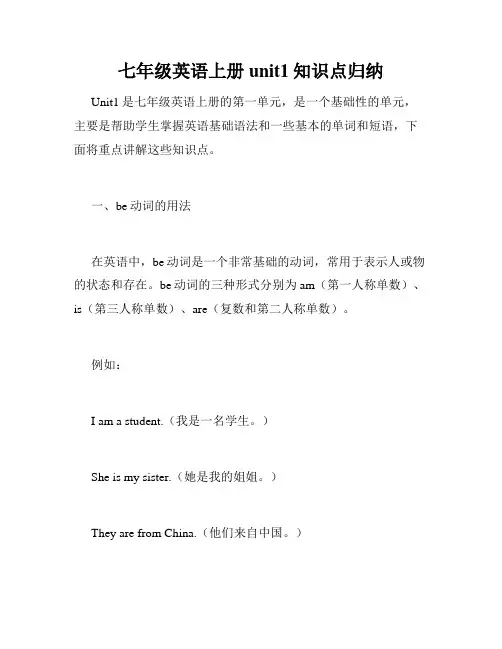
七年级英语上册unit1知识点归纳Unit1是七年级英语上册的第一单元,是一个基础性的单元,主要是帮助学生掌握英语基础语法和一些基本的单词和短语,下面将重点讲解这些知识点。
一、be动词的用法在英语中,be动词是一个非常基础的动词,常用于表示人或物的状态和存在。
be动词的三种形式分别为am(第一人称单数)、is(第三人称单数)、are(复数和第二人称单数)。
例如:I am a student.(我是一名学生。
)She is my sister.(她是我的姐姐。
)They are from China.(他们来自中国。
)二、there be句型there be句型是指以there为主语,用be动词表达某处有某物的句型,其基本结构为:There + be动词 + 名词。
例如:There is a red book on the desk.(桌子上有一本红色的书。
)There are some flowers in the garden.(花园里有一些花。
)三、数字和时间的表达数字和时间是英语中普遍用到的东西,七年级学生需要掌握0-100的数字和用英语表达时间的基本方法。
数字:0-zero, 1-one, 2-two, 3-three, 4-four, 5-five, 6-six, 7-seven, 8-eight, 9-nine, 10-ten, 11-eleven, 12-twelve, 13-thirteen, 14-fourteen, 15-fifteen, 16-sixteen, 17-seventeen, 18-eighteen, 19-nineteen, 20-twenty, 21-twenty-one……时间:用am表示上午,用pm表示下午,例如7:30 am、3:45 pm。
四、基本短语和句型英语中还有很多常用的短语和句型,七年级学生需要掌握一些基础的短语和句型,下面介绍一些常用的短语和句型。
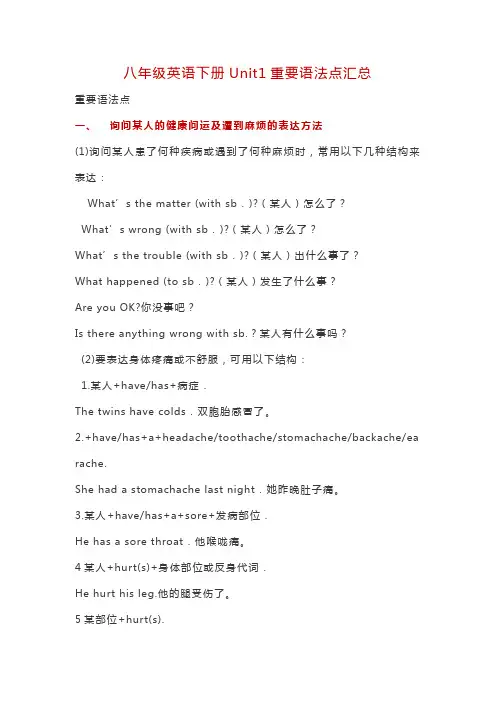
八年级英语下册Unit1重要语法点汇总重要语法点一、询问某人的健康问运及遭到麻烦的表达方法(1)询问某人患了何种疾病或遇到了何种麻烦时,常用以下几种结构来表达:What’s the matter (with sb.)?(某人)怎么了?What’s wrong (with sb.)?(某人)怎么了?What’s the trouble (with sb.)?(某人)出什么事了?What happened (to sb.)?(某人)发生了什么事?Are you OK?你没事吧?Is there anything wrong with sb.?某人有什么事吗?(2)要表达身体疼痛或不舒服,可用以下结构:1.某人+have/has+病症.The twins have colds.双胞胎感冒了。
2.+have/has+a+headache/toothache/stomachache/backache/ea rache.She had a stomachache last night.她昨晚肚子痛。
3.某人+have/has+a+sore+发病部位.He has a sore throat.他喉咙痛。
4某人+hurt(s)+身体部位或反身代词.He hurt his leg.他的腿受伤了。
5某部位+hurt(s).My head hurts badly.我头痛得厉害。
6某人+have/has+a pain+in one’s+身体部位,I have a pain in my chest.我胸口痛。
7.(There is)something wrong with one’s+身体部位.There is something wrong with my right eye..我的右眼有毛病。
8.其他表达方式She has a heart trouble.她有心脏病。
He got hit on the head他头部受到了撞击。
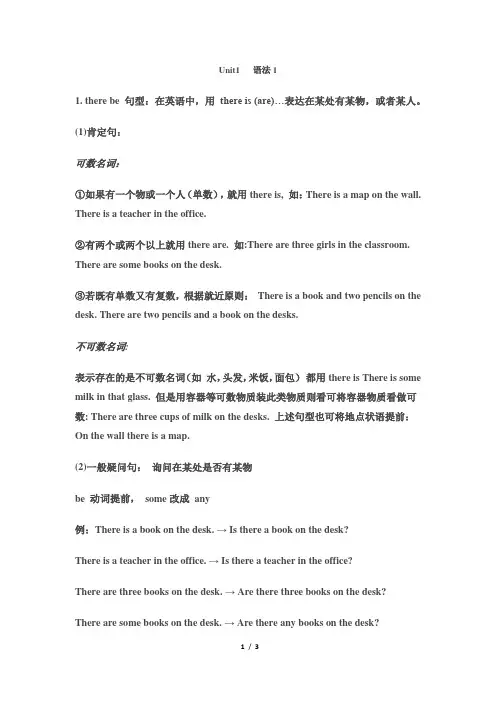
Unit1 语法11. there be 句型:在英语中,用there is (are)…表达在某处有某物,或者某人。
(1)肯定句:可数名词:①如果有一个物或一个人(单数),就用there is, 如:There is a map on the wall. There is a teacher in the office.②有两个或两个以上就用there are. 如:There are three girls in the classroom. There are some books on the desk.③若既有单数又有复数,根据就近原则:There is a book and two pencils on the desk. There are two pencils and a book on the desks.不可数名词:表示存在的是不可数名词(如水,头发,米饭,面包)都用there is There is some milk in that glass. 但是用容器等可数物质装此类物质则看可将容器物质看做可数: There are three cups of milk on the desks. 上述句型也可将地点状语提前:On the wall there is a map.(2)一般疑问句:询问在某处是否有某物be 动词提前,some改成any例:There is a book on the desk. → Is there a book on the desk?There is a teacher in the office. → Is there a teacher in the office?There are three books on the desk. → Are there three books on the desk?There are some books on the desk. → Are there any books on the desk?There is some milk in the glass. → Is there any milk in the glass?一般疑问句的回答为:Yes, there is. / No, there isn’t. (单数或不可数)Yes, there are. / No, there aren’t. (复数)(3)否定句:表示某处没有某物be 动词加not,some改成anyThere isn’t +可数名词(单数)如:There isn’t a pencil on the desk.课桌上没有铅笔。
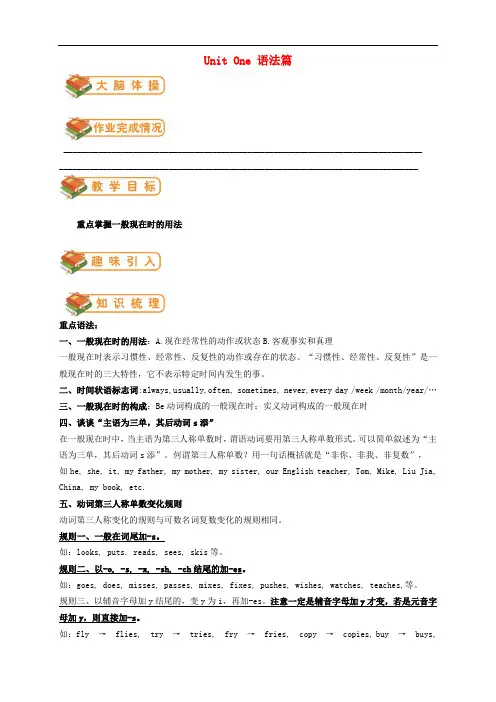
Unit One 语法篇____________________________________________________________________________________________________________________________________________________________________重点掌握一般现在时的用法重点语法:一、一般现在时的用法:A.现在经常性的动作或状态B.客观事实和真理一般现在时表示习惯性、经常性、反复性的动作或存在的状态。
“习惯性、经常性、反复性”是一般现在时的三大特性,它不表示特定时间内发生的事。
二、时间状语标志词:always,usually,often, sometimes, never,every day /week /month/year/…三、一般现在时的构成:Be动词构成的一般现在时;实义动词构成的一般现在时四、谈谈“主语为三单,其后动词s添”在一般现在时中,当主语为第三人称单数时,谓语动词要用第三人称单数形式。
可以简单叙述为“主语为三单,其后动词s添”。
何谓第三人称单数?用一句话概括就是“非你、非我、非复数”,如he, she, it, my father, my mother, my sister, our English teacher, Tom, Mike, Liu Jia, China, my book, etc.五、动词第三人称单数变化规则动词第三人称变化的规则与可数名词复数变化的规则相同。
规则一、一般在词尾加-s。
如:looks, puts. reads, sees, skis等。
规则二、以-o, -s, -x, -sh, -ch结尾的加-es。
如:goes, does, misses, passes, mixes, fixes, pushes, wishes, watches, teaches,等。
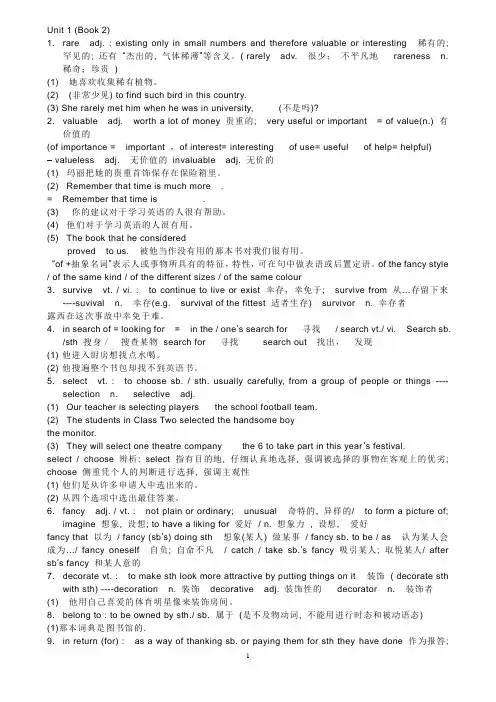
Unit 1 (Book 2)1. rare adj. : existing only in small numbers and therefore valuable or interesting 稀有的;罕见的; 还有“杰出的, 气体稀薄”等含义。
( rarely adv. 很少;不平凡地rareness n.稀奇;珍贵)(1) 她喜欢收集稀有植物。
(2) (非常少见) to find such bird in this country.(3) She rarely met him when he was in university, (不是吗)?2. valuable adj. worth a lot of money 贵重的; very useful or important = of value(n.) 有价值的(of importance = important ,of interest= interesting of use= useful of help= helpful)– valueless adj. 无价值的invaluable adj. 无价的(1) 玛丽把她的贵重首饰保存在保险箱里。
(2) Remember that time is much more .= Remember that time is .(3) 你的建议对于学习英语的人很有帮助。
(4) 他们对于学习英语的人很有用。
(5) The book that he consideredproved to us. 被他当作没有用的那本书对我们很有用。
“of +抽象名词”表示人或事物所具有的特征,特性,可在句中做表语或后置定语。
of the fancy style / of the same kind / of the different sizes / of the same colour3. survive vt. / vi. : to continue to live or exist 幸存,幸免于; survive from 从…存留下来----suvival n. 幸存(e.g. survival of the fittest 适者生存) survivor n. 幸存者露西在这次事故中幸免于难。
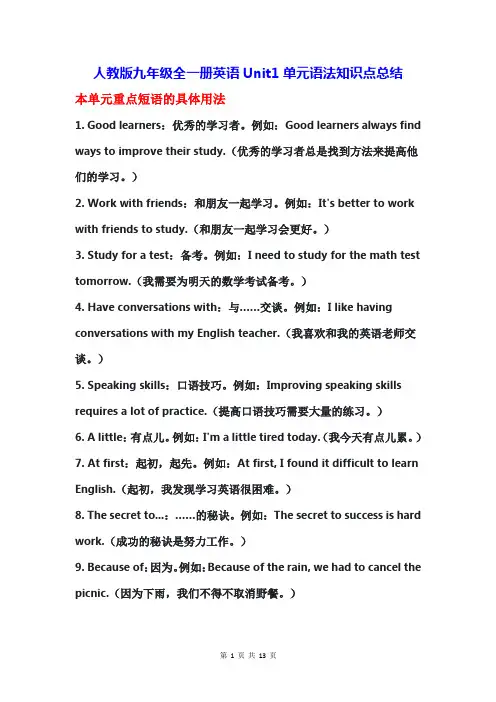
人教版九年级全一册英语Unit1单元语法知识点总结本单元重点短语的具体用法1. Good learners:优秀的学习者。
例如:Good learners always find ways to improve their study.(优秀的学习者总是找到方法来提高他们的学习。
)2. Work with friends:和朋友一起学习。
例如:It's better to work with friends to study.(和朋友一起学习会更好。
)3. Study for a test:备考。
例如:I need to study for the math test tomorrow.(我需要为明天的数学考试备考。
)4. Have conversations with:与……交谈。
例如:I like having conversations with my English teacher.(我喜欢和我的英语老师交谈。
)5. Speaking skills:口语技巧。
例如:Improving speaking skills requires a lot of practice.(提高口语技巧需要大量的练习。
)6. A little:有点儿。
例如:I'm a little tired today.(我今天有点儿累。
)7. At first:起初,起先。
例如:At first, I found it difficult to learn English.(起初,我发现学习英语很困难。
)8. The secret to...:……的秘诀。
例如:The secret to success is hard work.(成功的秘诀是努力工作。
)9. Because of:因为。
例如:Because of the rain, we had to cancel the picnic.(因为下雨,我们不得不取消野餐。
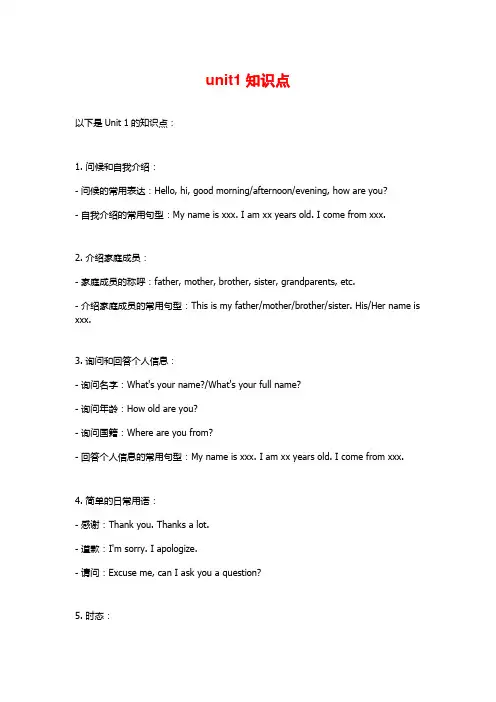
unit1知识点
以下是Unit 1的知识点:
1. 问候和自我介绍:
- 问候的常用表达:Hello, hi, good morning/afternoon/evening, how are you?
- 自我介绍的常用句型:My name is xxx. I am xx years old. I come from xxx.
2. 介绍家庭成员:
- 家庭成员的称呼:father, mother, brother, sister, grandparents, etc.
- 介绍家庭成员的常用句型:This is my father/mother/brother/sister. His/Her name is xxx.
3. 询问和回答个人信息:
- 询问名字:What's your name?/What's your full name?
- 询问年龄:How old are you?
- 询问国籍:Where are you from?
- 回答个人信息的常用句型:My name is xxx. I am xx years old. I come from xxx.
4. 简单的日常用语:
- 感谢:Thank you. Thanks a lot.
- 道歉:I'm sorry. I apologize.
- 请问:Excuse me, can I ask you a question?
5. 时态:
- 一般现在时:表述经常发生的事情、事实和真理。
- 现在进行时:表示现在正在进行或发生的动作。
这些是Unit 1的主要知识点,希望对你有帮助!。
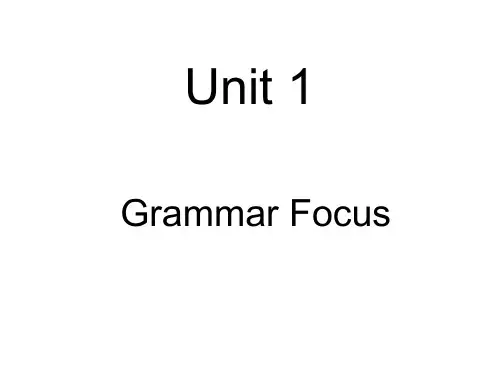
英语1(基础模块)第2版知识点及练习Unit One Nice to meet you !一、词汇(一),firstnum.第一(基数词one的序数词) ; n.第一,最初; 头等;adv.最初; 首先; at firstadj.第一流的; 最初的,最早的; 基本的;(二),lastn.末尾; 最后; 上个; vt. 经受住; 够用; 足够维持; vi.持续;adj.最近的; 最后的; 最不可能的; 惟一剩下的;adv.上一次,最近一次; 最后; at last(三),Mr. 先生,与Sir先生; Mrs. [misiz] 女士(已婚)Miss 小姐(未婚) Ms. [miz] 女士(婚姻状况不明)Madam 夫人,太太,小姐1. Mr. 意为"先生",Mr. 是Mister (先生)或Master (主人)的缩写。
一般用于男子姓氏或职务前;不管年龄大小;辈分长幼;职务高低;结婚与否,男子都可称为Mr.;后面跟姓。
如果一个男子的职务是校长,就可以称他为Mr.Headmaster (校长先生);Sir :对不相识的男子或上级;长辈或从事某种职务的男子表示尊称时,英;美人通常用sir,意为"先生;阁下;长官",后面不跟姓氏;如:—May I go now,sir?(先生,我可以走了吗?)—Yes,sir.(可以,先生;) sir还广泛用于各类信件中,如:Dear sir,Dear sirs;2. Mrs.意为"夫人,太太",是Mistress 的缩写。
常用于已婚妇女的丈夫的姓氏前;如果一个名叫Mary Jones的女子嫁给了一个名叫Jack White的男子,就称她为Mrs. White,但不能称Mrs. Jones;Mrs. Smith lives in Paris. 史密斯太太住在巴黎。
3. Miss意为"小姐",复数形式为Misses,用于对未婚女子的称呼;如果一个未婚女子名叫Rose Jones,可以称她为Miss Jones。
精品基础教育教学资料,仅供参考,需要可下载使用!Unit 1 How can we become good learners?第1课时Section A(1a2d)aloud adv.大声地;出声地pronunciation n.发音;读音。
其动词形式为pronouncepatient adj. 有耐心的。
n. 病人。
其反义词为impatient 【拓展】(1)aloud, loud和loudly都意为“大声地”,但用法有区别。
①aloud 强调能让人听得见。
常与动词read, call等连用。
如:Read aloud so that we can all hear you. 大点声读,以便我们大家都能听见你。
②loud 强调声音响亮。
常与动词speak, talk, say, laugh等连用。
常用比较级形式。
如:Facts speak louder than words. 事实胜于雄辩。
③loudly 有时可与loud通用,但含有“喧闹”或者“嘈杂”的意味。
如:Don't talk so loudly. 别这么高声说话。
(2)patient的常用短语:be patient with sb. 对某人有耐心;be patient to do sth. 有耐心做某事;be patient of…能忍受/容忍……have conversations with 和……交谈finish doing sth. 完成做某事give a report 做报告word by word 逐字/词地☆It's too hard to understand spoken English.理解英语口语太难了。
“It is+adj.+to do sth.”结构,it在句中作形式主语,真正的主语是动词不定式的内容。
如:He speaks in a low voice. It's too hard to hear him clearly. 他说话声音很低,太难听清楚他说什么了。
it的用法一、人称代词1. it的最基本用法是作代词,主要指刚提到的事物,以避免重复:①They watched the train until it disappeared in the distance.2.也可以指动物或婴儿(未知性别的婴儿或孩子):②Is this your dog?No, it isn’t.③They got a baby and it was a ten-pounder.3.代替指示代词this, that。
What’s this?—It’s a flag.Whose exercise-book is that?—It’s hers.4.也可指抽象事物或指抽象环境和情景:③I hate it when people talk with a full mouth..二、非人称代词1.it有时并不指具体的东西而泛指天气、时间、日期、距离、价值、度量、温度、环境等:⑴.指天气:It is a lovely day, isn’t it? ⑵.指时间: It was nearly midnight when she came back.⑶.指日期:It is April First today. ⑷.指距离:It is some 3000 kilometers from A to B.⑸.指价值:It is three dollars. ⑹.指温度:Today it is 30 degrees centigrade.三、其他用法(虚词)1.作形式主语,替代主语从句,动词不定式,或动名词短语:It is not a good habit to stay up late.(替代不定式)It is no use crying over split milk. (替代动名词)It is a pity that you didn’t read the book.( 替代that从句)It is uncertain whether he has passed the examination. (替代whether引导的从句)It is strange that he should ask you about it.(替代that引导的从句,有时需用虚拟语气)2.作形式宾语,替代宾语从句,动词不定式,动名词主语+believe, consider, count, feel, find, imagine, think, make, suppose, take + it +宾语补足语(形容词/名词/介词短语)+不定式/动名词/that 从句You must find it exciting working here. (替代动名词)I make it my business to settle the matter.(替代不定式)I’ve got to make it clear that my family was very poor.(替代that从句) 3.引导词it用作强调结构It is/ was +被强调部分(主语、宾语或状语)+who/that…Tom wore his cocktail dress to the banquet last night.a.It was Tom who/that his cocktail dress to the banquet last night.b.It was his cocktail dress that Tom wore to the banquet last night.c.It was last night that Tom wore his cocktail dress to the banquet.it 指名称相同的同一物,one指名称相同的另一物(泛指), that相同的另一物(特指)A: Are you still using your old car?B: No, I sold it the other day.A: I’ve just bought a new car.B: I’m going to buy one next week.The climate of my native town is not so warm as that of Fujian. some, othersone, the otherneither, either, none, both, allanother另外一个I’m in a hurry; I’ll see you another time.。
必修一Unit1重点句型及语法1、Mom asked her if (whether) she was very hot with so many clothes on.(p3)考点:with复合结构:with + 宾语+ v. –ing / v. –ed / to do / adj. / adv. / prep. phrases由“介词with+宾语+宾语补足语” 构成的复合结构在句中通常作为状语,表示背景情况,为方式,原因或条件等,另外,该结构也可以作为定语使用。
下面简述几种情况:1) 如果在该结构中的分词表示的动作是由前面的名词或代词发出的,构成主谓关系,该分词用现在分词形式。
2) 如果分词表示的动作与前面的名词或代词构成动宾关系,该分词用过去分词形式。
3) 宾语补足语也可以使用介词短语,形容词或副词来充当。
简化1.with + 宾语+ 副词,如:The square looks more beautiful with all the lights on (= while all the lights are on).With his parents away (= As his parents are away), Tom becomes more naughty.2.with + 宾语+ 介词短语,如:The teacher came in with a book in his hand (= while a book was in his hand).The girl looked up with tears in her eyes (= while tears were in her eyes).3.with + 宾语+ 现在分词,如:With summer corning (= As summer is corning), the weather is becoming hotter and hotter.With the teacher standing beside (= As the teacher was standing beside),she felt a bit uneasy.4.with + 宾语+ 过去分词,如:With the work done (= As the work had been done), she felt greatly relieved.With his hair cut (= As his hair has been cut), he looks much younger.5.with + 宾语+ 不定式,如:With her to go with us (= As she will go with us), we're sure to have a pleasant journey.With Mr Smith to teach them English next term(= As Mr Smith will teach them English) , they will be greatly improved in spoken English.练习题单选1. With nothing _______to burn the fire became weak and finally died out.A. leavingB. leftC. leaveD. to leave2. The girl sat there quite silent and still with her eyes _______on the wall.A. fixingB. fixedC. to be fixingD. to be fixed3. I live in the house with its door _________to the south.A. facingB. facesC. facedD. being faced4. They pretended to be working hard all night with their lights____.A. burnB. burntC. burningD. to burn完成句子1._______________________________ I couldn't go to see the doctor. (do)有太多的工作要做,我不能去看医生2. She sat___________________________________. (bend)她低头坐在那里。
Unit 1 What’s the matter?一.Have的用法归纳总结①have的基本含义意为“拥有”,“具有”,第三人称单数为has。
e.g. I have three brothers but Linda doesn’t have brothers or sisters.②have可表示“吃,喝,玩,做”等常见的动作,这时其为实义动词。
e.g. have a good day 玩的开心have breakfast/lunch/dinner 吃早/中/晚餐Have a rest 休息③have 表示“患病”,第三人称单数为hase.g. I have a cold.I have to look after my sister because she has a stomachache.二.情态动词should的用法①should意为“应该”,表示责任或义务,可用于各种人称。
e.g.We should protect the environment. 我们应该保护环境。
Be supposed to 意为“被期望,本应”,后+动词原形,相当于情态动词shoulde.g. We are supposed to study hard.= We should study hard.②should表示推测,指有一定根据的推测,常译为“按道理说应该”。
e.g. She left hours ago. She should be home now. 她几小时前就离开了,按道理说现在应该在家。
③should表示说话人的惊奇,愤怒,失望等特殊情感。
e.g. He is always the first,but he should be late this morning.他总是第一个到,但今天早晨他竟然迟到了。
④should表示提供帮助、建议、或要求对方给出意见。
e.g. What should she do?She should take her temperature.I think you’d better lie down and rest.三.反身代词的用法(Reflexive pronouns)①反身代词的形式:表示动作回执到其执行者本身,用以加强语气,意为“我(们)自己、你(们)自己,他/她/它(们)自己”的代词称为反身代词。
九年级英语unit1知识点笔记在九年级的英语学习中,Unit1是非常重要的一个单元,它包括了很多基础的语法和词汇知识,是我们后续学习的基础。
在这篇文章中,我将为大家总结九年级英语Unit1的知识点。
一、动词时态1.一般现在时:表示经常性的、习惯性的或普遍的动作、状态。
2.一般过去时:表示过去某个时间发生的动作。
3.一般将来时:表示将来某个时间将要发生的动作。
动词时态是英语中非常基础的部分,也是我们需要掌握和运用的重要知识点。
在学习中,我们可以通过语境和练习来加强对动词时态的掌握。
二、冠词冠词分为定冠词和不定冠词,定冠词包括"the",不定冠词包括"a"和"an"。
冠词在句子中起到限定名词的作用,能帮助我们更准确地表达意思。
在使用时,我们需要注意单复数和名词的首字母等情况,以便正确选择和运用冠词。
三、形容词和副词的比较级和最高级1.比较级:用于比较两个人或物的特征,形容词的比较级通常在词尾加上-er,或在前面加more。
2.最高级:用于比较三个或三个以上人或物的特征,形容词的最高级通常在词尾加上-est,或在前面加most。
形容词和副词的比较级和最高级是用来描述人或事物的特征或程度的。
掌握好这一部分的知识,对于我们的写作和口语表达都非常重要。
四、名词的单复数名词的单复数变化规则比较多,有一些名词的变化规则需要特别注意。
比如,以-f或-fe结尾的名词,变为复数时,通常把f或fe变为v,再加-es。
在写作和阅读时,我们需要注意名词的单复数变化,以便准确地表达意思。
五、介词介词在英语中是非常重要的一部分,它用来表示时间、地点、方向、原因等概念。
常见的介词有in、on、at、by等。
学习介词需要通过大量的语境练习,同时还需要注意介词与名词之间的搭配,以及一些特殊用法。
以上就是九年级英语Unit1的知识点笔记,希望能对大家的学习有所帮助。
英语学习是一个循序渐进的过程,只有掌握好基础,才能在后续学习中更好地应用和拓展。
Part Two Grammar―、句子结构和时态1.基本句子结构说明:S =主语;V =谓语;P =.表语;O =宾语;Ol =间接宾语;02 =直接宾语; C =宾语补足语。
(l)s+v(主谓结构):在此句式中,V是不及物动词。
e. g. My ink has run out.(我的墨水用完了。
)(2逆+V+P(主系表结构):在此句式中,V是系动词。
e. g. The story sounds interesting.(这个故事听起来很有趣)(3)S+V+0(主谓宾结构):在此句式中,V是及物动词。
e. g. They have taken good care of the children.(他们把这些孩子照顾得很好。
)(4)S+V+01 +02(主谓双宾结构):在此句式中,V是带有双宾语的及物动词。
常见的须带双宾语的动词有give, ask,bring,offer,send, pay,lend,show, tell,buy,get, rob,warn 等e. g. He brought me a pen/a pen to me.(他给我带了一支钢笔。
)(5)S+ V+O +C (:(主谓宾宾补结构):在此句式中,V是带有宾语补足语的及物动词。
常作宾语补足语的词有形容词、副词、介词短语、名词、不定式、现在分词、过去分词。
e. g. They made the girl angry.(他们惹得这个女孩生气了)2.时态复习(1)一般现在时的用法:①表示经常的或习惯的动作,常与表示频度的时间状语,如:always, often等连用。
e. g. He usually goes to school by bus.(他通常坐公交车上学。
)②表示客观事实和普遍真理ce. g. The earth moves around the sun•(地球绕着太阳转)③表示将来时间。
A.在简单句中常用于表示不可改变或不可轻易改变的动作或状态be, begin, come,go, leave,sail,start,arrive,return 等动词。
e. g. The bus leaves every ten minutes.(公交车每隔十分钟发车。
)B.在时间和条件状语从句中。
e. g. He will call us as soon as he arrives at school.(他一到学校就会打电话给我们。
)(2)现在进行时的用法:①表示现在正在发生的事情或进行的动作。
e. g. He is swimming now.(他现在正在游泳)②表示现阶段正在进行而现在时刻不一定在进行的动作。
e. g. Is your daughter working hard this term?(这学期你女儿学习努力吗?)③某些位移动词(如:go, come, leave, arrive, start等)的现在进行时可以表示将来时。
e. g. When are you leaving?(你什么时候离开?)④表示情感时常与always,forever,constantly等词连用。
e. g. He is always thinking of helping others.(他总是想着帮助别人。
)(3)现在完成时的用法:①表示过去某一时间开始并一直持续到现在的动作或状态。
e. g. You have lived here for a long time.(你在这儿住了很久了。
)(含义是现在仍然住在这儿。
)②表示过去发生或完成的动作或状态对现在造成的影响或结果。
e. g. I have spent all of my money.(我花光了所有的钱)(含义是我现在没有钱花了。
)(4)一般将来时的用法:①用shall/will + v•表示,shall用于第一人称,will用于各个人称。
e. g. He will fly to Shanghai tomorrow morning.(明早他要飞往上海)We shall/will see the film next week.(我们将于下周看这部电影3)②用be going to表示,主语是人表示说话者的主观看法,主语是物表示有迹象表明将要发生或者即将发生某种情况。
e. g. They are going to have a picnic this Sunday.(他们打算这个周日去野餐=)It is going to rain.(天马上就要下雨了。
)(5)一般过去时:①表示过去某个时间里发生的动作或状态。
e.g. He played tennis last week.(上星期他打过网球。
)②表示过去习惯性、经常性的动作或行为等,这个动作或状态现在已经结束了。
e. g. She often came to help us those days.(那些天她经常过来帮助我们。
)(6)过去进行时:表本过去某时正在进行的动作。
e. g. He was playing football this time yesterday.(昨天这个时候他正在踢足球。
)(7)过去完成时:表示过去某一时间或动作之前已经发生或完成了的动作。
e. g. I had had supper by 8:00 yesterday.(昨天晚上八点我已经吃过晚饭了。
)(8)过去将来时:表示从过去的某一时间来看将来要发生的动作或存在的状态。
e. g. He said he would fly to Shanghai the next day.(他说他第二天要飞往上海。
)二、重要语言点1.Teachers are involved in many tasks, such as explaining lessons, giving homework and correcting papers..教师的任务有多种,如授课、布置作业、批阅书面作业等。
involve (in)意为“包含;需要;使成为必要部分”。
e. g. The job involves travelling abroad for three months each year.(这项工作需要每年出国三个月。
)The plan involves the cooperation of both young and old.(这项计划需要年轻人和老年人的合作。
)I. Complete the following sentences with the given verbs in their proper forms.(用所给动词的适当形式填空。
)1.The year 2010___________(see) remarkable changes in Shanghai's landscape.2.This kind of glasses___________(wear) comfortably.3.It is the first time I___________(visit) the Bird^ Nest.4.— Can you give me some advice on what I said just now?—Sorry, my mind___________(wander).5.They___________ (mean) to see me off at the airport, but they got there late.6. I___________(leave)in a minute. I___________(finish) all my work before I leave.7.Mary's birthday is next Monday, and her mother___________(give) her a present.8.I didn’t know if she(come), but if she came I___________(let) you know.9.They saw empty glasses and cups and realized that three people___________(be) in the room.10.She ___________(play) tennis quite well, but she hasn't had time to play since she moved to the new school.11.I first___________ (meet) Lisa three years ago. She___________( work) at a radio shop at the time.12. Listen! Who___________(cry) over there? Let*s go and have a look.Translation (翻译。
)1.我来这个学校有三年多了。
(现在完成时)2.无论布朗一家去哪里,他们都受到了热烈欢迎。
(一般过去时)3.听!简在教室里唱歌。
(现在进行时)4.如果我们努力尝试,我们将能够按时完成工作。
(If)5.我没想到举办一个聚会需要这么多的工作。
(involve)Grammar (语法。
)Directions :After reading the passages below, fill in the blanks to make the passages coherent and grammatically correct. For the blanks with a given word, fill in each blank with the proper form of the given word ;for the other blanks, use one word that best fits each blank.(A)A society is made up of people from all walks of life. Here introduces us some of the occupations. The first occupation is teachers. Teachers work in schools, colleges, universities and (1)___________educational institutions. They do many tasks, such as explaining lessons, giving homework and correcting papers. They help students gain new knowledge and become useful people. The second one is surgeons. Surgeons (2)___________work in hospitals operate (3)___________ sick people,repair the organs and take care of the patients, medical treatment(4)___________they get well. The third one is secretaries. The job of a secretary often(5)___________(involve) writing letters,answering telephone calls, receiving people, and(6)___________(help) the boss work out plans and timetables. Traditionally, more girls than boys work as secretaries. The fourth one is fashion models. Fashion models wear the (7)___________(late) styles of clothes and show them tous through television, newspapers and magazines. The clothes and hair styles of fashion models may seem strange to (8)___________elderly, but are popular with young people.(B)Two college students, Debbie and Simon have part-time jobs at a travel agency. When they were sitting at work, people always (1)___________(prefer) Debbie to Simon. Simon wondered why. (2)___________ senior employee, Mr. Young, told him that it was the way he (3)___________(communicate). Simon often rested his head on his hand and looked downwards. He never smiled, and didn’t turn his head (4)___________ body towards people. His whole appearance didn’t give people a good impression and seemed (5)___________(tell) people to go away. However, Debbie was different. She held her head up, looked at people’s eyes and smiled. Her body language made people (6)___________(feel) welcome. Therefore people went to Debbie for assistance. Hearing Mr. Young’s words, Simon decided (7)___________( improve) his bodylanguage. He sat up and smiled at people. Minutes later, a beautiful girl entered. She went to Simon (8)___________hesitation and gave Simon a big smile. When she left, she was still smiling.Mr. Young thought Simon's change worked, while Simon told him she was his sister and she came to remind him that tomorrow is her birthday.Part Three Reading and WritingCertainly dustmen prefer to be known as " Reuse Collection and Disposal Officers(垃圾回收处理官员). You may think that this is rather ___1_____, and it is better to call a spade a spade (直言不讳)。